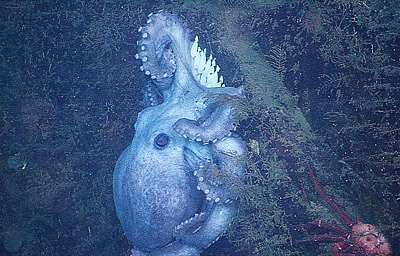Deep-sea octopus broods eggs for over 4 years—longer than any known animal

Researchers at the Monterey Bay Aquarium Research Institute (MBARI) have observed a deep-sea octopus brooding its eggs for four and one half years—longer than any other known animal. Throughout this time, the female kept the eggs clean and guarded them from predators. This amazing feat represents an evolutionary balancing act between the benefits to the young octopuses of having plenty of time to develop within their eggs, and their mother's ability to survive for years with little or no food.
Every few months for the last 25 years, a team of MBARI researchers led by Bruce Robison has performed surveys of deep-sea animals at a research site in the depths of Monterey Canyon that they call "Midwater 1." In May 2007, during one of these surveys, the researchers discovered a female octopus clinging to a rocky ledge just above the floor of the canyon, about 1,400 meters (4,600 feet) below the ocean surface. The octopus, a species known as Graneledone boreopacifica, had not been in this location during their previous dive at this site in April.
Over the next four and one-half years, the researchers dove at this same site 18 times. Each time, they found the same octopus, which they could identify by her distinctive scars, in the same place. As the years passed, her translucent eggs grew larger and the researchers could see young octopuses developing inside. Over the same period, the female gradually lost weight and her skin became loose and pale.
The researchers never saw the female leave her eggs or eat anything. She did not even show interest in small crabs and shrimp that crawled or swam by, as long as they did not bother her eggs.
The last time the researchers saw the brooding octopus was in September 2011. When they returned one month later, they found that the female was gone. As the researchers wrote in a recent paper in the PLOS ONE, "the rock face she had occupied held the tattered remnants of empty egg capsules."
After counting the remnants of the egg capsules, the researchers estimated that the female octopus had been brooding about 160 eggs.
Most female octopuses lay only one set of eggs and die about the time that their eggs hatch. The eggs of Graneledone boreopacifica are tear-drop-shaped capsules the size of small olives. As the young develop inside the eggs, they require plenty of oxygen. This means that the female octopus must continuously bathe the eggs in fresh, oxygenated seawater and keep them from being covered with silt or debris. The female must also guard her eggs vigilantly to prevent them from being eaten by predators.
Because the young octopus spend so much time in their eggs, by the time they hatch they are fully capable of surviving on their own and hunting for small prey. In fact, the newborns of G. boreopacifica are larger and better developed than the hatchlings of any other octopus or squid.
In their recent paper, the researchers point out that octopus eggs, like those of other invertebrates, develop more slowly in cold water. The seawater near the ocean floor at the Midwater 1 site is about three degrees Celsius (37 degrees Fahrenheit), which is typical for the depths of Monterey Canyon.
Given this chilly environment, it's not surprising that octopuses are not the only deep-sea animals to brood their young for long periods of time. One type of mysid (a shrimp relative that is abundant in depths of Monterey Canyon) carries its eggs for 20 months and goes without food the whole time. Like octopus hatchlings, the young of this shrimp also emerge from their eggs as fully developed miniature adults.
Such long brooding times present an evolutionary challenge, especially for animals such as octopus, which do not live very long. As the authors noted in their paper, "The trade-off within the reproductive strategy of deep-living octopods is between the mother's ability to endure a long brooding period and the competitiveness of her hatchlings. Graneledone boreopacifica produces hatchlings that are very highly developed, which gives them the advantage of a high potential for survival."
This research suggests that, in addition to setting records for the longest brooding time of any animal, Graneledone boreopacifica may be one of the longest lived cephalopods (a group that includes octopuses, squids, and their relatives). Most shallow-water octopuses and squids live just a year or two.
"The ultimate fate of a brooding female octopus is inevitably death," the researchers wrote, "but in this first example from the deep sea, brooding also confers an extension of adult life that greatly exceeds most projections of cephalopod longevity."
Although long-term observations of deep-sea animals are rare, the researchers propose that extended brooding periods may be common in the deep sea. Such extended life stages would need to be taken into account in assessing the effects of human activities on deep-sea animals. In any case, this strategy has apparently worked for Graneledone boreopacifica—it is one of the most common deep-sea octopuses in the Northeastern Pacific.
Journal information: PLoS ONE
Provided by Monterey Bay Aquarium Research Institute





















